Benefits of Investing in a Great Water Test Kit
You may wish to test the drinking water in your house for a variety of reasons. You might be curious to discover how many of the typical drinking water pollutants your water contains after learning about a local scare or after learning about them in general.
If you have your own well, you might want to make sure the water is safe to drink or you could just be interested in the water’s quality.
Whatever your reason, testing your water is now more affordable and simple than ever. No longer is it necessary to spend hundreds of dollars on a lab test; costs are reasonable, and there are many solutions available.
I’ll be presenting the best water test kit in this guide that you may use to test your water at home. Keep reading to the end since I’ve included all the information you could need to know about water testing kits there.
Best Home Water Test Kits
Comparison Chart of Water Test Kits

SimpleLab Tap Score: Top Overall
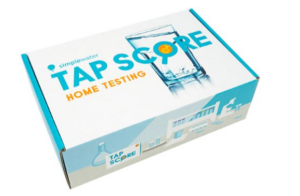
Tap Score is a broad range of laboratory water tests that SimpleLab offers. There are eight at-home add-ons, 54 specialty tests, three municipal water test choices, three well water test options.
You may select the ideal Tap Score test for you, regardless of what you want to test for in your water—whether you want a broad analysis or testing for a specific pollutant.
The three options for evaluating city water are: Essential City (45); Advanced City (108); and Extended City (118).
The three options for well water testing are: Essential Well (51 tests), Advanced Well (111 tests), and Extended Well (182 tests). The possibilities are unlimited with customised packages.
You will get a box in the mail after ordering a Tap Score test that contains vials, a user guide, and all other necessary testing supplies. After five days of sending the sample to the lab, you’ll have the Tap Score report.
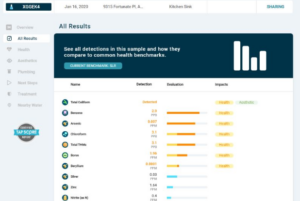
The interactive report goes into great detail about the toxins found in your water, their detection (in parts per billion or parts per million), a “assessment” of how much of each contaminant is present, and any possible aesthetic or health issues.
Using Tap Score, you can test for a variety of pollutants, from the more prevalent ones like fluoride, heavy metals, bacteria, and chlorine to the less prevalent ones including radiologicals, flame retardants, perchlorate, and hexavalent chromium.
In summary, the pros for SimpleLab Tap Score is that it has hundreds of tests to choose from, tests for even the most specific contaminants, as well as dedicated options for city water and well water.
However, the cons for this is that even the cheapest tests may be too expensive for small budgets. The overwhelming number of options may also make it difficult to narrow your choices down.
National Testing Laboratories Water Test Kit
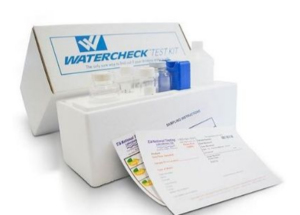
Many test kits for both well water and municipal water are available from National Testing Labs. The price of a kit depends on how many pollutants it tests for; the lowest kit costs approximately $170 and tests for 32 contaminants, while the most costly kit costs around $290 and tests for an astounding 115 toxins.
The pollutants that are most likely to be present in water, such as metals, chemicals, materials, uranium, and disinfectants and their byproducts, may be detected with even the cheapest Home water test kit.
If you’re unsure of what you should test for in your water, National Testing Labs has a quiz-style page where you may select options based on whether you have well or city water, then add-ons based on your primary concerns, such as color, flavor, or germs.
You only need to fill the water sample containers given by National Testing Labs and send them to the lab utilizing assured next-day delivery once you’ve bought a testing kit for your house. You’ll get a thorough report comparing your findings to EPA guidelines in a matter of days.
In conclusion, the benefits include the fact that it checks for extremely particular pollutants like uranium and slime microorganisms, which are difficult to locate elsewhere. Depending on the needs, there are alternatives for testing for a variety of pollutants or specific particles.
For individuals who are unsure of what they want, it also includes a useful selection page in the form of a quiz. It is well known to be quite costly, and the cost does not include return postage.
Safe Home ULTIMATE Water Quality Test Kit
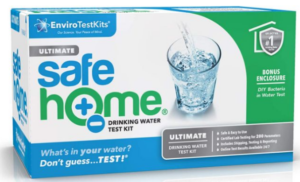
The Safe Home ULTIMATE Water Quality kit, which costs little under $400, analyzes drinking water for more than 200 different factors. The standard procedure for a DIY laboratory testing product is followed by this water testing kit: you collect your water samples in the provided containers, send them to the Safe Home laboratory, and receive your test results via email in around 14 business days.
The Safe Home ULTIMATE water testing kit does not let you select the pollutants you wish to test for, but that’s good because it checks for pretty much everything that may possibly be in your water. This test kit will detect anything in your water, from metals to physical characteristics, TTHMs to semi-volatile organic compounds and volatile organic compounds, bacteria to inorganics.
A certified laboratory is used by the Safe Home test kit, and you will be informed when the lab receives your samples and when you can anticipate your findings. You may check for bacteria on your own with the DIY Bacteria in Water test that is provided with the test.
In conclusion, one benefit is that it is reputed to offer full, comprehensive examination. Also, it includes a free at-home bacteria test and sends email updates when the water sample is received. Results, however, could not appear until three weeks. Furthermore, it is silent on the “safeness” of the discovered contamination levels.
Quality Water Treatment Well Water Test Kit
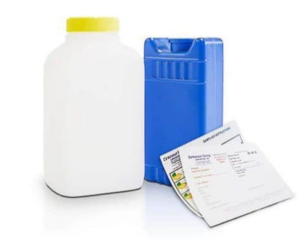
For analyzing samples of well water, use the Quality Water Treatment Well Water Testing kit. You will be needed to take a sample of your well water from your tap and submit it to the QWT laboratory because it is a laboratory-style product.
A water therapy expert will then be in touch with you to go through the results with you when you receive an email with your results.
Depending on whether you choose the Lite, Basic, or Standard kit, this water testing kit looks for 32–87 contaminants. The Lite covers the pollutants you’d probably want to rule out and is the least expensive option. It includes 7 inorganic compounds, 22 heavy metals, and 5 physical variables.
The Standard kit is the most complete option and tests for everything from lead and arsenic to uranium, fluoride, nitrates, VOCs, disinfection byproducts, and TDS. The Basic kit additionally tests for bacteria (total coliform and e coli).
Your QWT water test kit may be split into 4 interest-free installments if you don’t want to pay for it all at once, which is very convenient. If you need to test your tap water quickly, you won’t have to wait long to get the water test kit in the mail because all orders are completed within one day.
The benefit of this, in short, is that it is simple to use and comprehend. There are up to three different kits to pick from, and it is regarded as one of the most thorough solutions for testing well water. It might not be the ideal choice for municipal water, though, and it is somewhat expensive in comparison to the other options on our list.
Health Metric Drinking Water Test Kit: Excellent For DIY
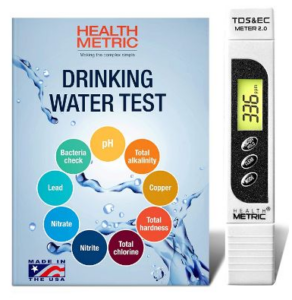
An at-home test kit for wells and public tap water is available under the name Health Metric Drinking Water Test Kit. Tests for nine typical pollutants, including copper, lead, coliform bacteria, pH, total alkalinity, hardness, total chlorine, and nitrate, may be performed on a water sample using the kit’s simple-to-read test strips.
It’s quick and easy to use this kit: just dip one of the included test strips in your sample, and then compare the color-coded findings with the color chart in the booklet that comes with it. You’ll be informed of the degree of pollution in your water when the strip’s color changes.
This kit has the benefit of testing for nearly all the primary characteristics you’d need to check for in city or well water, although being slightly more expensive than other at-home water tests. A single pack contains numerous tests, each with its own set of instructions.
With the exception of the bacteria kit, which requires a few days to complete, the remainder of the water tests included in this package yield quick results.
It is highly user-friendly, in my opinion, and very comprehensive for a kit to be used at home. It also offers top-notch customer support. However, it is more expensive to acquire than other tests of a similar nature, and some consumers have complained about erroneous findings.
Watersafe Drinking Water Test Kit
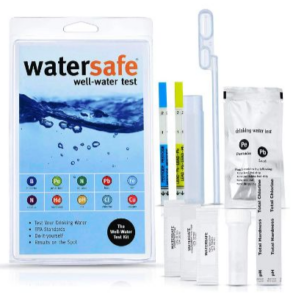
Color-coded test strip kit called the Watersafe Drinking Water Test Kit. These strips can test your tap water for lead, bacteria, pesticides, pH, hardness, copper, iron, nitrate, and nitrite. The Watersafe is a low-cost at-home testing solution that comes with everything you need to check for common pollutants. It costs less than $30.
The Watersafe kit’s lead testing stands out because it is very clear and has been verified in an EPA-certified laboratory for lead detection at minute levels. You may rest easy knowing that you are adequately protected, even from pollutants that you weren’t aware existed, because this kit can screen for odorless and colorless compounds.
The Watersafe is an excellent choice to use often for peace of mind because it’s quite inexpensive to acquire. The pack contains 6 different tests, each of which may only be used once (unlike some kits, which can be reused). Findings are often fairly exact and easy to understand.
This test kit’s simplicity of use and accuracy, particularly for lead, results are what I enjoy about it. Also, it checks for usual pollutants. It can’t be used again, and several consumers complained about its accuracy.
Test Assured Test Kit For Drinking Water
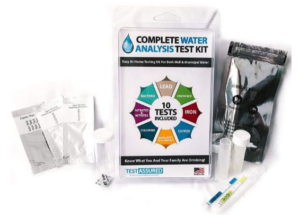
If you don’t need to test your water for everything, but you do need to check for TDS and 10 of the most prevalent pollutants, the Test Assured water test kit is a good choice. This kit checks for everything you’re most likely to discover in your tap water: iron, lead, nitrates and nitrites, copper, pH, hardness, chlorine, and total dissolved solids.
With this kit, laboratory testing is not necessary. This at-home testing system is simple to use. To find out exactly what’s in your water, just collect some samples of your own tap water and follow the instructions.
If you want to be sure that the water coming from your tap is compliant with legal requirements, the Test Assured kits are a smart choice because they are developed in accordance with EPA regulations for water quality restrictions.
The TDS meter may be used again, making this kit somewhat more cost-effective than other DIY testing kits even if most of it is single-use. You may use a TDS meter to see whether a filter system you installed improved your TDS levels. This water test kit is reasonably priced at around $45, considering what you get.
The fact that it comes with a reusable TDS meter and is backed by a 100% satisfaction guarantee are two things I enjoy about it. Results are also produced in a matter of minutes. A thorough explanation of the results is not provided, and some customers have considered the lead tests to be ineffective and overly simplistic.
Hach Total Hardness Test Strips
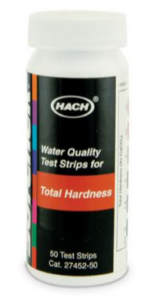
The Hatch Complete Hardness Test Strips might be helpful if you believe you have a hardness issue and are eager to learn more about how serious the issue is. Each of the 50 strips in a single kit tests hardness on a scale of 0 to 425 ppm or 0 to 25 gpg.
If addressed, hardness can be a serious problem. You may use the color chart that is included with the Hatch strips to pinpoint exactly how hard your water is. If you utilize this kit to determine that you have a high degree of hardness, which implies a larger probability for limescale, you may use this information to choose a softening solution for your home.
The Hatch strips have an approximate 1.5-year expiration date, similar to the majority of at-home testing strips. You may ask why so many strips are given if you won’t likely need to use all 50 in that time, unless you built a softener and wanted to check on it frequently.
You will need to have a clean container on hand in order to get a sample of water because the strips don’t come with anything but a color chart.
This test kit’s ability to provide a precise indicator of water hardness is something I appreciate. The majority of people agree that the exam was highly accurate. Also, it offers very quick effects. It won’t provide you with a comprehensive idea of hardness, and the contrast between the colors on the scale is quite large.
Buying Guide For Water Test Kits
It’s critical that you know what to look for when purchasing water test kits. If you don’t truly know the alternatives that are accessible or the characteristics that might be useful in certain situations, you could not end up with the greatest water test kit for you. This buyer’s guide will support you in that endeavor.
Everything you need to know has been addressed, including the many kinds of water test kits that are offered, factors to take into account when purchasing a drinking water test kit for your house, and a few commonly asked questions.
Different Types of Water Quality Test Kits
These four most common kit tests will likely be available if you search online for water test kits:
Lab Sample Kits
The most expensive water testing option is lab sample kits, but they are also the most precise. You may avoid performing the actual testing yourself by using a kit like this one for testing water. You will only gather a vial of water and send it to the lab.
When utilizing lab water testing kits to test your water, you have a lot of options. For the most thorough investigation of the components of your water, you could choose a full water analysis. To save money, you might also decide to test for a small number of pollutants, depending on the alternatives the laboratory provides.
With the opportunity to select the best drinking water test kit depending on your preferences and water source, the majority of businesses that provide lab testing kits may offer far more comprehensive testing options (well water or city water, problems with taste, staining, odor, etc). For piece of mind, look for a lab that has earned NSF accreditation; these laboratories have third-party clearance of the services they offer, so they won’t squander your money.
Any characteristic that exists, including water hardness, volatile organic compounds, bacteria, medicines, chemicals, and heavy metals, may be tested for using lab water testing kits.
The fact that lab sample kits typically cost at least $100 per water test kit is what most people find most off-putting. The time it takes for test results to get back from the lab can take up to two weeks, which isn’t ideal if you’re in the middle of a possible emergency and believe your water may be severely poisoned.
Test Strips
The most economical and user-friendly method of evaluating water is with test strips. You may test your water at home using test strips, which considerably reduces expenditures. Online test strips typically range in price from $10 to $30, depending on the test’s quality and the number of contaminants it checks for.
The standard procedure for using a test strip kit is to dip the test strip in a sample of water (or running water, depending on the instructions in the kit). While testing your water, you should be careful not to touch any of the test strip’s several distinct squares.
When exposed to water, each of these squares symbolizes distinct contamination and will change color. This color’s intensity will tell you how noticeable certain pollutants are in your water.
To help you comprehend your results, a color chart will be given to you.
Compared to submitting your test results to a lab, this testing approach is far quicker, less expensive, and more practical. Nevertheless, rather than testing for all contaminants at once, test strips can only detect a limited number of them. To test for water hardness, bacteria, and chlorine/chloride, for example, you might need to buy several tests for the best level of accuracy.
You won’t have a precise grasp of how polluted your water is since test strips can only use a color scheme to identify what’s in your water. Furthermore bear in mind that you might not be able to obtain a test strip kit that can provide you the information you want if you’re seeking for anything really specialized, like radium.
Color Discs
A color disk water test is still a possibility, albeit it’s less common. In this kind of test, you fill a plastic container with water, then place the container within a little box. This package includes a color disc. Just spin the disk until you find the color that most closely resembles the color of your sample. Your findings will indicate the level of water contamination.
Your findings won’t be as quick with color disc tests since they need more labor than test strips. However, it is doubtful that these discs will test for several criteria; in fact, they seldom test for as many toxins at once as water test strips do.
A color disc is often used to check for just one kind of pollutant, such as phosphate, iron, nitrate, or chlorine. If you want to test for several contaminants, this might make it more expensive.
Digital Instruments
Use of a digital water testing device can be an alternative if you’re seeking for a non-disposable solution. Digital pH readings and TDS (total dissolved solids) meters are two of the most used instruments.
By measuring how acidic or alkaline water is, a pH reader can usually determine what kinds of pollutants it may contain. Acidic water with a pH measurement of 6.5 or below is more prone to contamination by pollutants, whereas alkaline water is likely to have a greater mineral content (and maybe a higher water hardness) and a lower total contaminant concentration. Also, it is more corrosive, which might eventually cause issues for your pipes and plumbing.
Before plunging the probe into a fresh container of tap water to use a pH sensor, calibrate it in a neutral buffer solution (with a pH reading of 7). A pH reading will be sent to you in 2 minutes. It’s not quite as easy as it appears since the pH reader needs to be calibrated to ensure that your reading is correct.
TDS meters are excellent for evaluating your water’s overall quality. Total dissolved solids, or TDS, measures the quantity of dissolved solids in water, both good and harmful. The EPA rates most tap water’s TDS measurement of 300 ppm (parts per million), which is considered “excellent,” as “good.”
Nonetheless, it’s advised that your water’s TDS stay between the range of 500-600 ppm, since anything greater than that might mean your water has more dangerous chemicals than usual.
A TDS meter, like a pH reader, is a digital portable tool that may be used to quickly examine your water. A TDS meter measures the conductivity of the water when you dip it in, and it uses that information to determine the TDS.
Although it won’t tell you what’s actually in your water, a TDS meter might be useful if you want to know if a water purification system, such as a good reverse osmosis unit, is operating.
The dissolved solids in your water may be identified using a drinking water test kit. They are therefore more enticing to those seeking precise information.
Lab vs At Home Water Test: Which is Better?
You might find that conducting your own water testing at home is sufficient for you. Whether you simply want to have a general understanding of the toxins in your water or you want assurance that it is pure. Using one of the DIY water test kits recommended in this tutorial will probably work for you in that situation.
At-home examinations, however, do not come close to matching the breadth or precision of a lab test. While you’ll have a general idea of what’s in your tap water, a water test kit you’ve used at home won’t provide precise measurements. Whether testing water from a private well or having concerns about water pollution in your home, lab tests can be quite helpful.
In this instance, one is not superior than the other. For on-the-grid water users who only want to know if their water is pure or not, at-home water test kits are usually the most cost-effective choice.
If you need to test for issue pollutants more extensively or you utilize your own water supply that you are accountable for monitoring and managing, lab tests are an useful backup choice.
Factors To Consider When Buying a Water Testing Kit
The following points are important to think about when you buy a water testing kit:
Source of Water
It’s possible that your water source may tell you which pollutants to check for. Water hardness is perhaps the most frequent problem with water quality, so no matter where in the country you live, you’ll usually want to test for it. Where you live will determine whether or not, and how much, of virtually every other pollutant is present in your water.
If you use municipal or local water, it will be sanitized by local authorities before being delivered to your home, but this does not guarantee that it is contaminant-free.
Depending on your location, you may still want to test your water for fluoride, heavy metals, fluoride, chlorine, sulfur, and other chemicals that alter the taste, odor, or general quality of the water.
You might want to think about scheduling a lead test as well as lead is another pollutant that could appear in your tap water, particularly if the underground pipes in your neighborhood are quite old.
If you possess a private well, you are alone in charge of doing your own water testing. Once again, you may wish to conduct tests for impurities unique to certain wells, including iron, bacteria, sulfur, manganese, and water hardness.
For a private well, it is not as important to do a lead test or a chlorine test. This is so that lead won’t likely get into your private well (unless your well’s components are composed of lead), since well water isn’t chlorinated like municipal water (unless you do it yourself).
Testing Procedure
No matter whatever kind of home water test kit you use, the testing procedure is typically rather simple. In either scenario, you must collect a sample of your tap water and either send it to a lab for testing while you wait for the findings, or test the water right away.
Though a more accurate test alternative, lab testing is a far more drawn-out process. Choose a DIY test that can provide immediate results if you need to test water right away.
Contaminants Tested For
The majority of water test kits can check for a number of the most common pollutants in water, but some are far more specific than others.
A lab test is the most extensive type of water test available.
You’ll discover every detail about your water, including if it contains even minute amounts of impurities like lead, bacteria, iron, copper, fluoride, chlorine, and so on. The precision of water test kits makes them a wonderful choice for anyone who wants to test private well water. They may also be used to evaluate pH levels and total alkalinity.
Nonetheless, you might not always need or want to test for every possible contaminant. A DIY test kit, such as test strips, can do the trick if all you want to do is check your water source for the most prevalent toxins. Many tests for lead, chlorine, pH, hardness, and other pollutants are available and may be performed quickly at home.
I would advise thinking about professional testing if you have a reason to be concerned about a certain contaminant since you’ll obtain a more precise understanding of the issue you’re facing.
Test strips
Test strips are submerged in water. They alter the color to show what pollutants are present and how much of each one there is. The most popular at-home water testing kit uses test strips because they are practical, but their results aren’t always reliable.
Discs
Discs can be more costly but are often more precise than test strips. The discs simultaneously execute a number of tests. You pour water into each container that is reagent-filled. To show the presence of a contaminant, the reagent changes colors.
Digital Readers
Results are displayed on an LCD screen via a digital reader. These instruments frequently measure electrical conductivity, total dissolved solids, and temperature. These can be reused even if they can’t screen for particular pollutants.
Frequently Asked Questions
Are home water test kits accurate enough?
Although this is a bit of a loaded question, I’d say generally speaking, yeah. Although water test kits are not as precise as lab tests, if they are made properly, they will reveal the contents of your water. See customer testimonials to learn more.
It’s also important to consider the brand name and the product description because certain tests may come with certifications that may provide you peace of mind before you make a purchase.
It is important to be aware that the majority of kit tests have a limited shelf life. It’s also crucial to store your outfit away from heat and humidity because those circumstances can quickly cause harm to it. Store the kit according to the manufacturer’s instructions to ensure that your findings are as accurate as possible.
Should I test my water If my area’s authority already tests my water?
Even after your water supply has been examined and cleaned by the appropriate authorities in your region, there are a number of reasons you might wish to do your own testing on it.
For starters, when water travels via subterranean pipes to reach your house, pollutants like lead may leak into the water. Also, the authorities in your region will disinfect your water using chemical pollutants like chlorine or chloramine.
Lastly, even if your local government will lower certain pollutants in accordance with EPA guidelines, they might not completely remove them, meaning you might still be exposed to dangerous impurities.
How often should I test my water supply, and what should I test for if I have a private well?
You must test your well water for many pollutants and indications of water quality. They include pH, nitrates, VOCs, E. coli, coliform bacteria, and pH. Depending on where your well is located, you might also need to test for impurities including lead, hydrogen sulfide, copper, iron, arsenic, radium, pesticides, and mercury.
It is suggested that you test the pH, TDS, nitrates, and coliform bacteria in your well water once a year. Once every three years, or more frequently if you have well-related issues or have learned about local pollution, you should test your well water for additional toxins.
How often should my water be tested?
Check your water for common impurities like iron, germs, and lead as least once a year. If the safety of your water worries you, think considering conducting more regular tests or receiving verified lab findings rather than those from a home test.
Finally, it could be a good idea to get your water tested if there have been recent changes to your surroundings, such as neighboring land development.
How does a water testing kit work?
Several mechanisms are used by water testing kits. While some (more costly) kits employ a straightforward test strip procedure, other, less expensive versions involve mailing to an independent laboratory.
By ordering a mail-in kit, you may collect water samples, fill up a set of containers, and send them to a lab for analysis. The package will often include comprehensive instructions and a color-coded guidance on how to test for each pollutant if you’re using a strip test kit.
With an at-home kit, results may be seen considerably more quickly—in some cases, in only 15 minutes.
Do water test kits expire?
Water test kit expiration is true. Depending on the type of tests, they normally have a shelf life of three to five years after which they lose accuracy. Look for particular expiration dates on the package of your test.